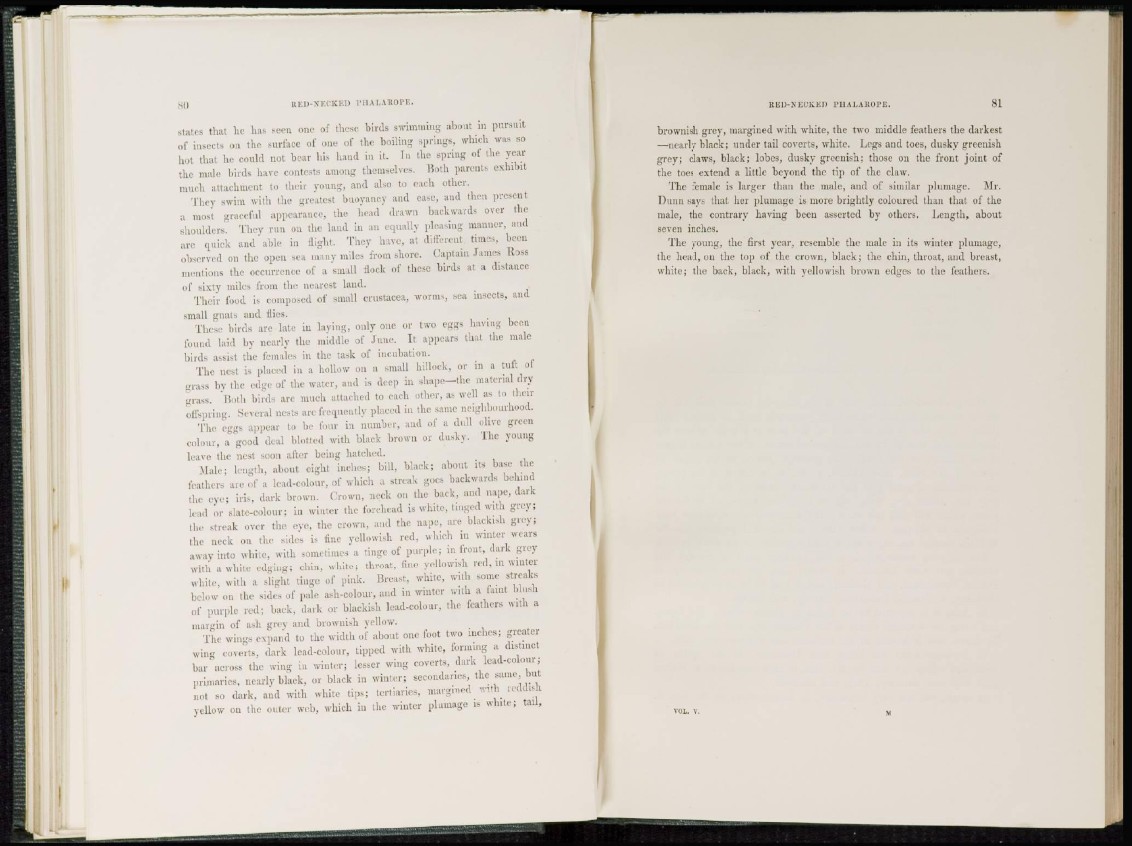
8 0 RED-NECKED PUALAEOPE.
states that he has seen one of these birds swimming about in pursuit
of insects on the surface of one of the boiling springs, which was so
hot that he could not bear his hand in it. Tn the spring of the year
the MALE birds have contests among themselves. Both parents exhibit
much attachment to their young, and also to each other.
They swim with the greatest buoyancy and ease, and then prescut
a most graceful appearance, the head drawn backwards over the
shoulders. They run on the laud in an equally pleasing manner, and
are quick and able in flight. They have, at different times, been
observed on the open sea many miles from shore. Captain James Uoss
mentions the occurrence of a small nock of these birds at a distance
of sixty miles from the nearest laud.
Their food is composed of small crustacca, worms, sea insects, and
small gnats and flics.
These birds are late in laying, only one or two eggs having been
found laid by nearly the middle of June. It appears that the male
birds assist the females in the task of incubation.
The nest is placed in a hollow on a small hillock, or in a tuft of
grass by the edge of the water, and is deep in shape—the material dry
grass. Both birds arc much attached to each other, as well as to their
offspring. Several nests are frequently placed in the same neighbourhood.
The eggs appear to be four in number, and of a dull olive green
COLOUR, a good deal blotted with black brown or dusky. The young
leave the nest soon after being hatched.
Male; length, about eight inches; bill, black; about its base the
feathers are of a lead-colour, of which a streak goes backwards behind
the eye; iris, dark brown. Crown, neck on the back, and nape, dark
lead or slate-colour; in winter the forehead is white, tinged with grey;
the streak over the eye, t h e crown, and the nape, are blackish grey;
the neck on the sides is fine yellowish red, which in winter wears
away into white, with sometimes a tinge of p u r p l e ; in front, dark grey
with a white edging; chin, white; throat, fine yellowish red, in winter
white, with a slight tinge of pink. Breast, white, with some streaks
below on the side-, of pale ash-colour, and in winter with a faint blush
of purple red; back, dark or blackish lead-colour, the feathers with a
margin of ash grey and brownish yellow.
The wings expand to the width of about one foot two inches; greater
wing coverts, dark lead-colour, tipped with white, forming a distinct
bar across the wing in winter; lesser wing coverts, dark lead-colour;
primaries, nearly black, or black in winter; secondaries, the same, but
not so dark, and with white tips; tertiaries, margined with reddish
yellow on the outer web, which in the winter plumage is white; tail,
R E D - N E C K E D I'll A LA H O P E . 8 1
brownish grey, margined with white, the two middle feathers the darkest
—nearly black; under tail coverts, white. Legs and toes, dusky greenish
grey; claws, black; lobes, dusky greenish; those on the front joiut of
the toes extend a little beyond the tip of the claw.
The female is larger than the male, and of similar plumage. Mr.
Dunn says that her plumage is more brightly coloured than that of the
male, the contrary having been asserted by others. Length, about
seven inches.
The young, the first year, resemble the male in its winter plumage,
the head, on the top of the crown, black; the chin, throat, and breast,
white; the back, black, with yellowish brown edges to the feathers.
VOL. V. M